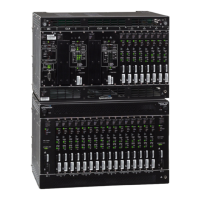1
TimeHub 5500 TL1 Reference Manual
13
Introduction
097-55501-02 Issue 5: June 2003
2
5
3
SSSSSSSSSSSS SSSS S SSSSS SSSSSSS S SSS SSSSS
S
Table A. Parameter Definitions
Parameter Definition Use
<aid> Access identifier Identifies the object of the command or message. May have more than
one part.
<almcde> Alarm code Identifies the severity of the alarm based on its priority of action. If
multiple alarms are reported, almcde is the highest severity of those
reported.
<atag> Automatic message
tag
A number assigned to sequence and correlate automatic messages.
<chap> Channel access
privileges
Enables or disables access to a port.
<conddescr> Condition description Text description of the condition.
<condeff> Condition effect Effect on the condition of the equipment. Can be raised (SC), cleared
(CL), or transient (TC).
<condtype> Condition type Type of alarm or event condition.
<ctag> Correlation tag Correlates input and response messages. Contains 1 to 6 alphanumeric
characters other than 0. Must be included in a command, and the same
ctag is returned in the response.
<date> Date Current date in 8-digit form: yy-mm-dd, where yy is the year, mm is the
month (01-12), and dd is the day of the month (01-31). For example,
May 3, 2000 is 00-05-03.
<errcde> Error code Four-character mnemonic error code. Refer to the Troubleshooting
chapter.
<error
message>
Error message Error code text message.
<keyword> Keyword Used with commands to accomplish a task. Refer to the Keywords
chapter.
<montype> Monitor type Performance monitoring data type. Refer to the Performance Monitoring
chapter.
<monval> Monitor value Performance monitoring data value. Refer to the Performance
Monitoring chapter.
<ntfcncde> Notification code Code that shows the event or alarm severity, which is one of the
following:
CR = critical alarm
MJ = major alarm
MN = minor alarm
CL = cleared
NA = non-alarmed
NR = not reported

